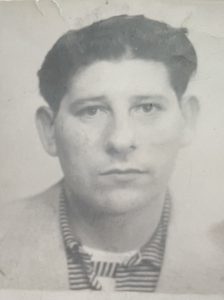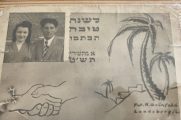- Local Survivor registry
- SAMUEL SZARFARC
- Local Survivor registry
- SAMUEL SZARFARC
Survivor Profile

SAMUEL
SZARFARC
(1923-2009)
PRE-WAR NAME:
SHMUEL SZARFARC
SHMUEL SZARFARC
PLACE OF BIRTH:
SOSNOWIEC, POLAND
SOSNOWIEC, POLAND
DATE OF BIRTH:
DECEMBER 24, 1923
DECEMBER 24, 1923
LOCATION(s) BEFORE THE WAR:
SOSNOWIEC, POLAND
SOSNOWIEC, POLAND
LOCATION(s) DURING THE WAR:
MULTIPLE LABOR CAMPS, POLAND; GRUNSBERG, GERMANY; KITTLITZSTREBBEN, BUCHENWALD
MULTIPLE LABOR CAMPS, POLAND; GRUNSBERG, GERMANY; KITTLITZSTREBBEN, BUCHENWALD
STATUS:
SURVIVOR
SURVIVOR
RELATED PERSON(S):
SARAH SZARFARC - Mother (Deceased),
JONAH SZARFARC - Father (Deceased),
MORDECHAI SZARFARC-BROTHER (Deceased),
BEN SZARFARC-BROTHER (Deceased),
RENE SZARFARC - Spouse (Deceased),
SUSAN GREENSTEIN - Daughter
-
BIOGRAPHY BY SUSAN GREENSTEIN, DAUGHTER
Sam Szarfarc (Salomon) was born December 24th, 1923 in Sosnowice, a rural town in Western Poland. His father’s name was Jonas, and mother’s name was Sarah. He was one of 11 children of an Orthodox Jewish Family. The family had a modest leather tanning business.
His hometown of Sosnowice, was occupied by the Germans in 1939, and he was thrust into forced labor, which was quite unfamiliar to him. He worked on “laying a railway”. He was 16 years old. He said it was backbreaking work. His father died here, being unable to do the hard work. His mother died of hunger in Sokoanice.
Samuel performed this heavy work until the beginning of 1942. He was then taken in a small transport to Grunberg Labor Camp located in Schlesien Germany. (This was a sub camp of the larger concentration camp system known as Gross-Rosen). Here he did forced labor of the hardest kind at the company called Deursche Wollenmanufactur Company. Here they produced textiles for soldier’s uniforms, army coats, parachutes and blankets for the army. Conditions were atrocious. He carried coal, and “loaded and unloaded” the coal. Here he feared for his life and people were shot in front of his eyes. The food was terrible and only made up of bread and soup.
In 1944 Samuel was sent to Kittlitztrebben (part of Gross-Rosen). Here he was called a Muselmann, a person who is starving and weak and resigned to their impending death. Then he was sent to Buchenwald, where he fell ill with typhus. He was in the camp hospital for three months and was finally liberated by the allied forces in 1945 from Buchenwald.
After liberation, in 1945 Samuel went to the Landsberg DP camp am lech. He was married there in 1947. He stayed there four years searching for survivors. He found two of his brothers and a cousin that had survived.
In 1949, he traveled on USNS General LeRoy Eltinge, a military ship sponsored by a Jewish charity and landed on the West side of Manhattan. He found his first job in America, stuffing feathers into pillows in Brooklyn for $0.25 cents per hour. He was able to get a small loan from relatives and opened a Grocery store in Brooklyn. In the early 70’s he sold his newer grocery store (a Superette), and purchased a failing leather finishing shop in the South Bronx reconnecting him to the trade he left behind in Poland.
Samuel had virtually no formal education, but he wrote and spoke four different languages. He admired the United States and always reminded us, his children, how lucky we were to live here.
-
SURVIVOR INTERVIEW:
REFER TO BIOGRAPHY ABOVE
-
HISTORICAL NOTES:
SOSNOWIEC
Before the war, there were about 30,000 Jews in Sosnowiec, making up about 20% of the town’s population.[5] Over the next two years the Germans resettled thousands of Jews from smaller towns to Sosnowiec, temporarily increasing the size of the local Jewish community to 45,000. By late 1942, Będzin and nearby Sosnowiec (which bordered Będzin), became the only two cities in the Zagłębie Dąbrowskie region that were still inhabited by Jews.
The city, located on the pre-war Polish-German border, was taken over by the Germans on the first day of the invasion of Poland.[7] Arrests and beatings among more prominent Jews began the next morning. On 9 September 1939 the Great Synagogue in Sosnowiec was burned.[8] Local Jews were being evicted from better homes and terrorized on the streets. Jewish businesses were plundered by individual soldiers and closed by the Nazis pending confiscation proceedings. Shootings and first mass executions followed soon afterwards. Forced relocations into crowded tenements slowly created a ghetto.
Judenrat and the Jewish police were soon established on German orders; the head of the Sosnowiec Judenrat was Moshe Merin (Mojżesz Merin in Polish). Food rationing was introduced. The Jews were prohibited from buying anything outside their own community. In the first months of 1940 the Zentrale der Jüdischen Ältestenräte in Oberschlesien (Central Office of the Jewish Councils of Elders in Upper Silesia), headed by Merin, was created in Sosnowiec, representing about 45 communities. For a time, Merin became infamous as the dictator of the Jews of the Zaglebie region, with the power of life and death over local Jews. A labour camp was established for the Jews deported to Sosnowiec from Czechoslovakia to work at the factory of the Shine brothers. Numerous forced labour facilities were established for the locals; making uniforms, underwear, corsets, bags, leather handbags, and military boots.[6][12] In 1940 some 2,592 German war profiteers arrived in the city. By 1942, their number rose to 10,749 settlers, constituting 10% of the general population.
Ever since the ghetto was established, numerous deportation actions were organized by the Germans with the help of the Judenrat and Merin, selecting healthy men for slave labor at the camps. Large transfers of Jews took part in May (1,500) and June 1942 (2,000). Around October 1942 – January 1943 the ghetto was moved to the Środula district. Środula also bordered the site of the Będzin Ghetto. At this point about 13,000 Jews still lived in Sosnowiec. The creation of the Sosnowiec ghetto ended on 10 March 1943, when it was finally closed off from the outside world.
Thousands of Jews were deported from Sosnowiec to Auschwitz in June 1943 during the major deportation action extending to nearby Będzin.[17] The ghetto was liquidated two months later in August, whereas almost all remaining Jews were also deported to Auschwitz.[18] A few hundred Jews remained in the Środula ghetto, which was liquidated in January 1944 Retrieved USHMM Aug 2023
UPRISING
There had been considerable underground activity among the Jews in Sosnowiec and Będzin Ghetto nearby, organized by the youth organizations Ha-No’ar ha-Ziyyoni, Gordonia, and Ha-Shomer ha-Za’ir. During the final major deportation push in August 1943, the Jewish Combat Organization (Polish: Żydowska Organizacja Bojowa, ŻOB) in Będzin and Sosnowiec staged an uprising against the Germans. The uprising, which began on 3 August 1943, was led by Cwi (Tzvi) Brandes, Frumka Płotnicka, and the Kożuch brothers. It was the final act of defiance of the local population with no chance of success. Most of the young Jewish fighters perished (400 killed in action), fighting the overwhelming German forces. The last Holocaust transport to Auschwitz-Birkenau with Jews forced to bury the dead, left Sosnowiec on 15 January 1944.
-
related textual material:
.
-
Sources and Credits:
Credits:
Biography of Samuel Szarfarc donated by Susan Greenstein, daughter
The SSBJCC Holocaust Memorial and Education Center gratefully acknowledges the donation by Susan Greenstein of digital copies of family photographs and historic documents of her survivor parents.





